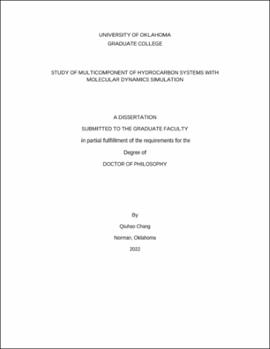| dc.description.abstract | Molecular Dynamics (MD) simulation is a powerful tool used in various research fields such as petroleum, geoscience, biochemistry, physics, and materials science. The unique merit of MD simulation is that it can investigate the complex structures or systems of interest at the atomic or molecular level, which could be inaccessible to experimental methods. A naturally accumulated hydrocarbon reservoir is a complex multi-component system where complex phase behavior occurs when different recovery techniques are applied. Given that hydrocarbons are stored in nanoscale to mesoscale pores, MD simulations have widely been used in petroleum engineering to study the interaction between pore-wall and fluids inside the pore body. For example, MD simulation has been widely used to observe the adsorption/desorption and diffusion of gas molecules in carbon nanotube/nanoslit for understanding the gas behaviors in the shale reservoir. Similarly, hydrocarbon products such as asphalts are complex mixtures that pose challenges in molecular-level studies but can be good candidates for MD simulation. In summary, MD has been used in this dissertation research to study the interfacial tension change for CO2 EOR and rejuvenating asphalt.
The first research project uses MD to study the options for rejuvenating aged asphalts with waste cooking oil (WCO) and waste polyethylene (WPE). The asphalt binder in pavement degrades over time due to oxidation and loss of volatile components resulting from weathering and utilization. Using waste to modify and recycle aged asphalt brings environmental and economic benefits. MD study of WCO for the aged asphalt shows that adding 10 wt% Triglyceride (TG, the main component of WCO) can decrease the viscosity (from 83 cP to 69 cP) and increase the self-diffusion coefficient (from 2.81×10^(-7)to 3.24×10^(-7) (cm^2)/s) of aged asphalt at its compaction conditions. The radial distribution function analysis revealed that the asphaltene-asphaltene nearest neighbor distance increased from 4.0 Å to 7.5 Å. The optimal dosage of TG was determined, which should be in the range of 10-15 wt% of aged asphalt. The results illustrate the fundamental mechanism of using the WCO to reclaim aged asphalt.
The WPE simulation shows that adding WPE could reduce the interactions between asphaltenes-resins, asphaltenes-aromatics, and asphaltenes-saturates. Low compatibility between asphalt and polyethylene results in phase separation of PE-modified asphalt. The maleic anhydride functional group (MAH) is chemically grafted on WPE (WPE-g-MAH) to enhance the compatibility and stability between PE and asphalt. The simulation results show that adding MAH functional group enhanced the interactions between asphaltenes-saturates and asphaltenes-aromatics, which was why MAH could enhance the compatibility between asphalt and WPE. Moreover, the simulation results demonstrated that both WPE and WPE-g-MAH couldn’t affect the interactions between asphaltenes-asphaltenes and mitigate the formation of asphaltene aggregations/clusters in aged asphalt, indicating PE and PE-g-MAH are not potential options to restore the rheological properties of aged asphalt.
The second project in this dissertation research uses MD simulation to study the interfacial tension between CO2-rich oil and the aqueous phase, which could fundamentally explain one of the synergetic driving mechanisms for CO2-related EOR. Recent laboratory tests showed promising results using urea as a CO2-generating agent for in-situ CO2 EOR. However, laboratory tests could not quantify the interfacial tension changes due to CO2 partitioning to the oil and aqueous phases. MD simulation is performed to study the interface and properties of the CO2/water/oil multi-components system in this research project. The simulation results demonstrate that the CO2 concentration of 40% is required to achieve a good reduction of the water/oil IFT for low-pressure conditions (<10 MPa) with 345 K, and that the water/oil IFT decreases significantly when the CO2 concentration is between 0 and 40%. While at higher CO2 concentrations of 40–80%, the IFT reduction is small. The literature has not reported this relationship between water/oil IFT and CO2 concentration. Our findings quantify the contribution of IFT reduction to oil recovery in CO2 EOR techniques. In addition, at low CO2 concentrations of 0~40%, CO2 molecules would change the orientation from the random distribution to parallel to the water/oil interface. Once the contact region of water/oil is saturated by CO2 molecules at around 40% concentration, increasing the CO2 concentrations does not change much of the IFT or CO2 orientation. This study illustrates the mechanism of IFT reduction from the molecular perspective that interfacial CO2 orientation is affected by bulk CO2 concentration and is closely correlated to the IFT change between oil and aqueous phases. The fundamental study of CO2 behavior at the water-oil interface is important to in-situ CO2 EOR and all CO2 flooding mechanisms. In addition, the procedures and analysis methods can be applied to other EOR projects for binary and multi-component systems studies for IFT analysis and property computation. | en_US |
